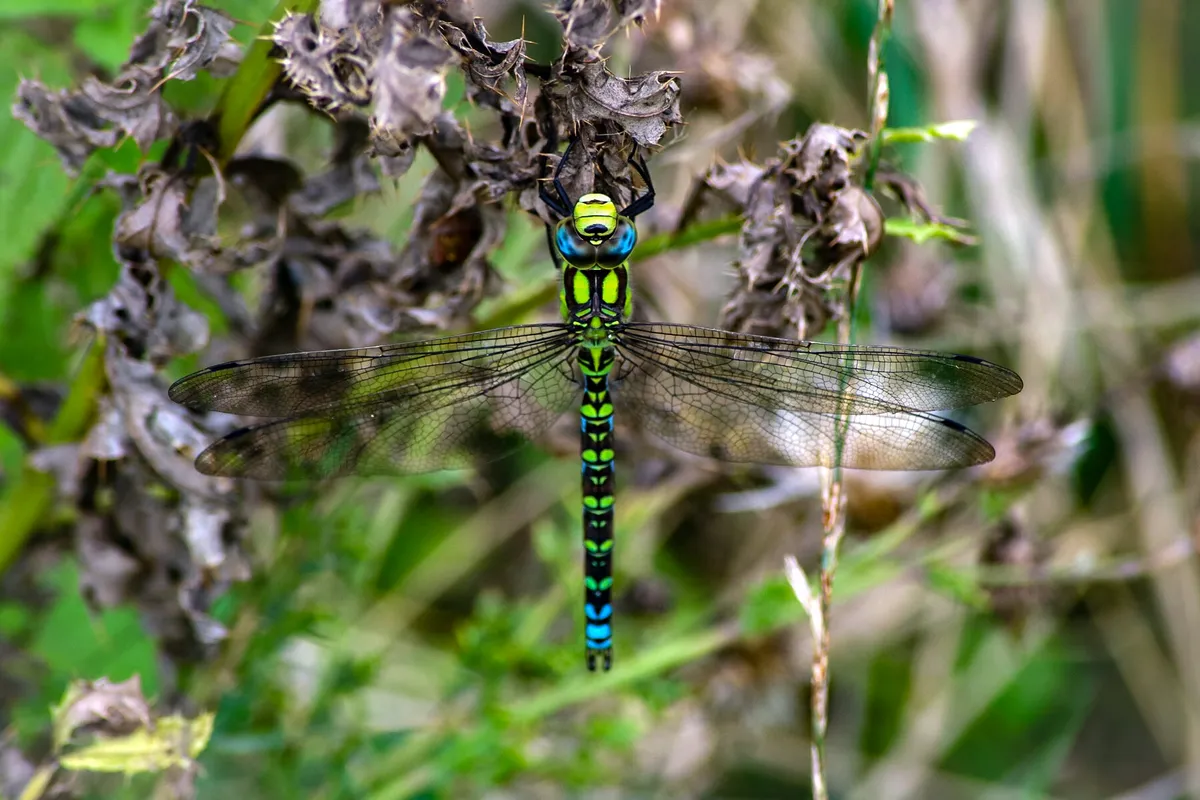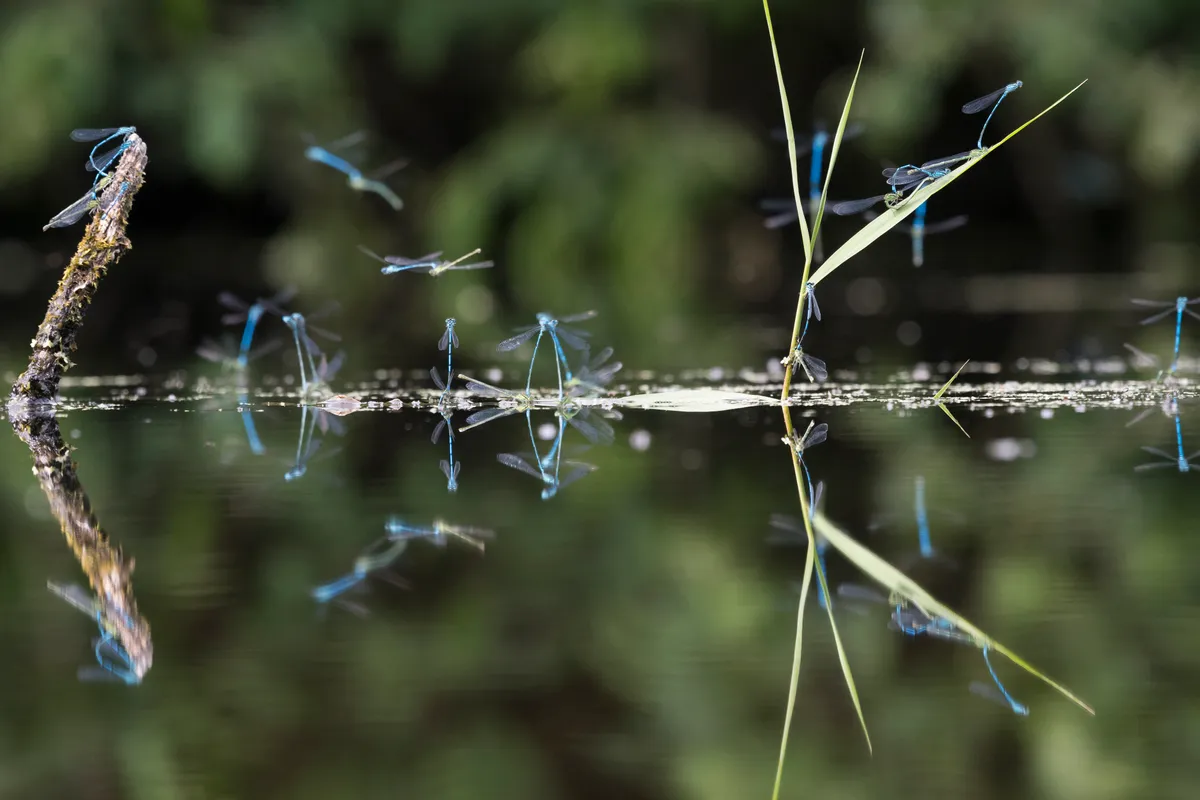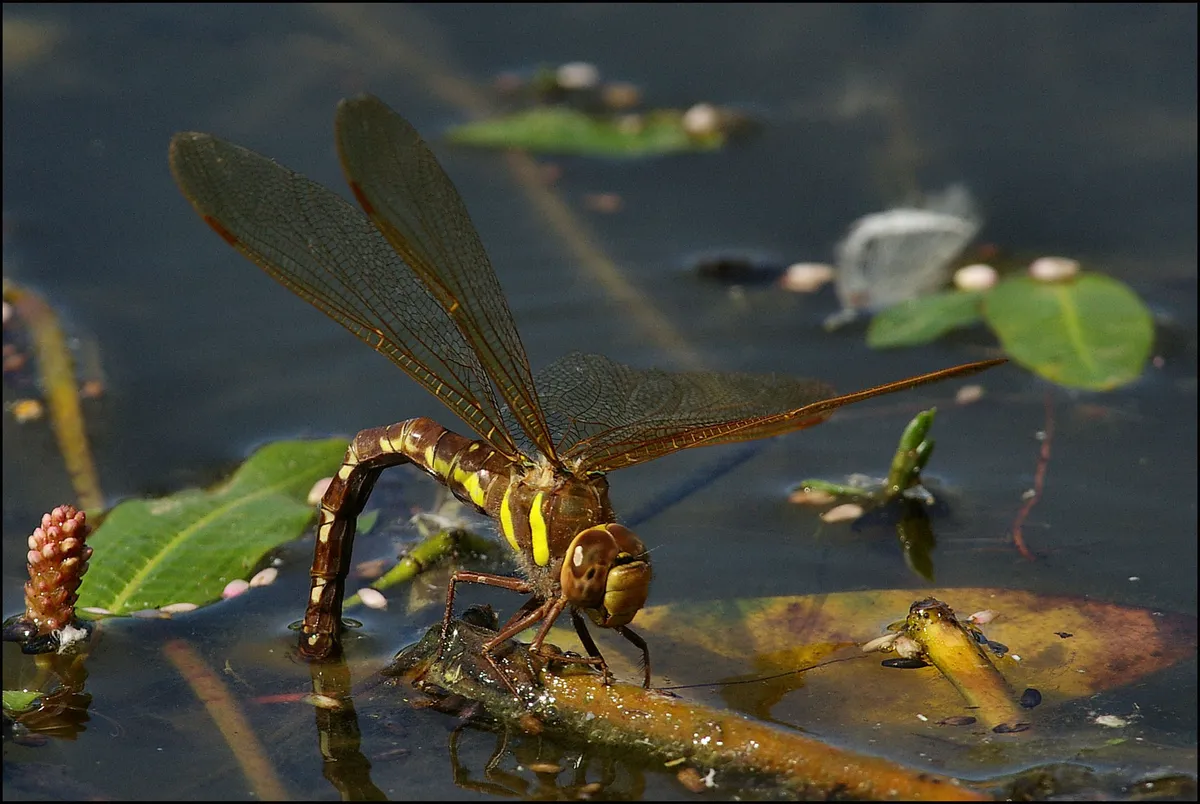There are few UK insects that are as visually pleasing, with such an interesting life cycle, as dragonflies and damselflies. Known for their acrobatic aerial displays and often photographed visiting garden ponds and waterways over the summer months, they begin and spend most of their life underwater, adults having carefully laid their eggs in and around freshwater streams, rivers and ponds. Although they belong to the same order of insects – Odonata – there are a few differences between the groups, the main visual one being that dragonflies hold their wings out horizontally when at rest, whereas damselflies hold their wings together, above their backs. There are more than 5,000 known species worldwide, and almost 60 in the UK.
Jump to
Damselflies and dragonflies begin and spend most of their life underwater
Eggs are shaped according to where they are laid, damselflies and hawker dragonflies lay elongated, oval-shaped eggs directly into aquatic plant material with a scythe-like ovipositor. Emerald dragonflies and migrant hawkers lay their eggs in stems above the water surface, and other hawkers lay on rotten wood above the waterline. Chasers, skimmers and darters lay round eggs in a jelly substance direct into water, so they float.

Most nymphs hatch after just a few weeks, although some eggs will overwinter depending on when they were laid. Once hatched, nymphs immediately begin feeding voraciously on small aquatic animals including worms, molluscs, leeches, tadpoles and small fish, and will moult several times as they grow over a period of months, or sometimes years. Larvae can be found all year round in all kinds of freshwater, small temporary ponds to large rivers and lakes. They live in different micro aquatic habitats, some at the bottom in leaf litter, some cling on to aquatic plants, but always clean and unpolluted freshwater and are therefore an excellent indicator of water quality.
Adults usually live for just a few weeks or months

Adults emerge in spring with emergence timing synchronised in some species to reduce predation. The larvae climb up out of the water using vegetation or rocks, and then the adults gradually push themselves out of their larval skin to reveal their winged bodies, which can take several hours. Adults may take a few weeks to become fully mature and ready to mate, after which they form a mating loop with their partner for the transfer of sperm. This process can take anywhere from a few seconds to several hours, after which the female will lay the fertilised eggs into or around freshwater to start the whole cycle again.
Gardeners can attract both dragonflies and damselflies easily by introducing freshwater
Although dragonflies and damselflies can live to several years old, adults usually live for just a few weeks or months as most of their lifespan is spent as larvae under water. As adults they are aerial predators, favouring smaller summer-abundant insects such as mosquitoes and midges, making them excellent garden companions and important biological controls globally. Although not preyed upon by many other insects, adults do provide food for birds, bats and reptiles making them an important element of the garden food chain. Gardeners can attract both dragonflies and damselflies easily by introducing freshwater – a container pond as small as 1m² can be sufficient to encourage all kinds of aquatic life, including dragonflies and damselflies, just ensure you have vegetation that breaks the pond’s surface to allow adults to lay eggs, and larvae to emerge.

As with many insect species, dragonflies are key indicators of climate change. Favouring warmer climes to lay their eggs, many species are moving northwards as global temperatures increase. This means that species that live at high altitudes may struggle to find habitat in future.
Read our Small Stories feature on aphids
This month is the Royal Entomological Society’s Insect Week (19 – 25 June) and its flagship event – a close up look into the miraculous world of insects with Martha Kearney, George McGavin, Levon Biss and Karen Wimhurst - will be held at The British Library on Friday 23 June. In person and online tickets are available from The British Library. If you know of an insect-related event happening near you, register it on the Insect Week website and join this annual celebration of the little things than run the world.
Find out more at www.insectweek.org
Dragonfly and damselfly fact file
- Dragonflies and damselflies have independently beating wings, can fly in any direction, and can even use their wings to turn back upright if dropped upside down.
- Even though they have six legs (as all adult insects do) most dragonflies and damselflies cannot walk. Their legs are adapted to grab prey as they fly or grasp onto plant stems.
- The aptly named globe skimmer dragonfly, Pantala flavescens, makes a multigeneration migration journey of 16,000km with non-stop sections of up to 2,500km. Controlling for body size, this is thought to be the longest non-stop migration by any animal.

- Dragonflies are ancient insects. The largest insect ever known to inhabit prehistoric earth was a dragonfly. Meganeuropsis permiana lived about 275 million years ago, when oxygen levels were much higher, allowing living creatures to develop into much larger beings. It had a wingspan of 75cm and weighed around 450g – the size and weight of a crow.
- Dragonfly and damselfly eyes can see and process more colours than the human eye. We can see three main colours (red, green and blue) whereas the advanced compound eye of day flying dragonflies and damselflies, can see four or five different colours, including Ultraviolet (UV).
- Both dragonflies and damselflies are voracious predators of other insects, including mosquitoes and midges. Each summer adults eat around a kilo of insects – dragonflies feeding on the wing and damselflies from a stationary position.
Follow #GISmallStories on social media to join the conversation.




